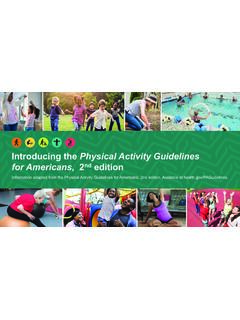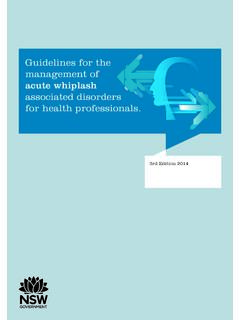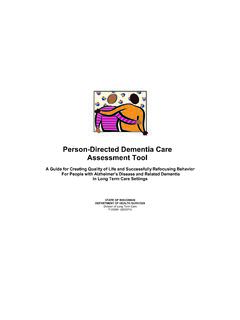Transcription of Mall Walking: A Program Resource Guide
1 mall walking A Program Resource Guide Suggested Citation Belza B, Allen P, Brown DR, Farren L, Janicek S, Jones DL, King DK, Marquez DX, Miyawaki CE, Rosenberg D. mall walking : A Program Resource Guide . Seattle, WA: University of Washington Health Promotion Research Center; 2015. Images in mall walking : A Program Resource Guide are numbered. See the photo credits on page 34 for a complete list of photos. For additional information, please contact Basia Belza, PhD, RN, FAAN University of Washington E-mail: Website addresses of nonfederal organizations are provided solely as a service to readers.
2 Provision of an address does not constitute an endorsement of this organization by CDC or the federal government, and none should be inferred. CDC is not responsible for the content of other organizations web pages. Contents i Contents ii Authors iii Acknowledgements iv Project advisory Group 1 Introduction 2 Why Walk? 3 Why mall Walk? 6 mall walking Program Considerations 16 Examples of mall walking Programs 25 Think Beyond a Traditional mall walking Program 32 References 34 Photo Credits 35 Appendices 44 walking Resources Contents Authors Basia Belza, PhD, RN, FAAN Sarah Janicek, MEd, MAHealth Promotion Research Center, School of Nursing, University of Washington Department of Kinesiology and Nutrition University of Illinois at Chicago Laura Farren, BS David X.
3 Marquez, PhD, FACSM, FGSA Health Promotion Research Center, University of Washington Department of Kinesiology and Nutrition, Center for Research on Health and Aging, University of Illinois at ChicagoChristina E. Miyawaki, PhD, MSW Group Health Research Institute, Health Promotion Research Center, University of Washington Dori Rosenberg, PhD, MPH Group Health Research Institute, Health Promotion Research Center, University of Washington Dina L. Jones, PT, PhD Department of Orthopaedics, Division of physical Therapy, Injury Control Research Center, West Virginia University Peg Allen, PhD, MPH, BSN Prevention Research Center, Brown School, Washington University in St.
4 Louis Diane K. King, PhDCenter for Behavioral Health Research and Services, University of Alaska Anchorage David R. Brown, PhD National Center for Chronic Disease Prevention and Health Promotion, Division of Nutrition, physical activity , and Obesity, physical activity and Health Branch, Centers for Disease Control and Prevention mall walking : A Program Resource Guide ii Acknowledgements mall walking : A Program Resource Guide is a product of the University of Washington Health Promotion Research Center, the Centers for Disease Control and Prevention (CDC) Prevention Research Center, and was supported by Cooperative Agreement Number U48 DP001911 from the CDC.
5 Student Assistants Laila Tomkinson Allen, MPH student University of Alaska at AnchorageSarah Brollier, MPH University of Washington A. Jill Wagner, MA, at IconoGraph Designs, provided the design for mall walking : A Program Resource Guide , and produced the document. Marc Cormier, PhD University of Kentucky Special thanks to the following professional staff members and students who greatly contributed to the data collection and analysis, conceptualization, and design of mall walking : A Program Resource Guide : Michael Kelly, BSN, RN University of Washington Emma Preston, undergraduate student University of Illinois at Chicago Professional Staff Nicole Schaffer, BS University of Illinois at ChicagoYuki Durham Research Consultant, University of Washington Mackenzie Staub, MSW, MPH Washington University in St.
6 Louis Jeremy Thurston, BSN, RN University of Washington Rebecca Tiffany, BSN, RN University of Washington mall walking : A Program Resource Guide iii Project advisory Group Colin Milner Founder, International Council on Active Aging Ross Okawa, MPA, MEd Seattle, Washington David Sabgir, MD, FACC Founder, Walk with a Doc Stacie Sheridan Executive Director-in-Training, Era Living Communities, Seattle Susan Snyder, MS Executive Director, Evidence-Based Leadership Council Mary B. Waterman, MPH Director, Public Health, Arthritis Foundation, National Office Rachel Beyerle Communications Director, Easter Seals Transportation Group Michele L Boutaugh, BSN, MPH Office of Nutrition and Health Promotion Programs, Administration on Aging, Administration for Community Living, Department of Health and Human Services Paige E.
7 Denison EnhanceFitness National Trainer, Senior Services Christine Harding Program Director, Community Education Programs, National Council on Aging Margaret Haynes, MPA Director of Elder Care Services, MaineHealth Gloria Neault, MSN, RN Program Manager, Clinical Services, MaineHealth Heather Hodge, Director, Chronic Disease Prevention Programs, YMCA of USA mall walking : A Program Resource Guide iv Introduction The goal of mall walking : A Program Resource Guide (hereafter the Guide ) is to encourage the development of mall walking programs by providing readers with information about the health benefits of walking , explaining why mall walking programs can help people walk more, and providing practical strategies for starting and maintaining walking programs in malls or other venues in areas where a mall is not available.
8 The information in the Guide is based on a review of research on mall walking programs; environmental audits of malls and other venues with walking programs; and interviews conducted with walkers, Program leaders, and managers in malls and other venues with walking programs. This Guide is meant to inform several types of stakeholders (or audiences). It is primarily for mall managers who want to start or enhance a mall walking Program . However, it is also for others in the community, who want to partner with their community mall to either start a walking Program , or use an existing Program to help their constituencies ( , employees, patients, seniors) walk more.
9 This can include aging services providers, community coalitions, work site managers, public health professionals, and hospitals and health care providers. A roadmap follows next so that you can anticipate what to expect as you read the Guide s contents. This is a research-to-practice Guide . The research and rationale for planning, implementing, and evaluating mall walking programs is covered in the Why Walk? and Why mall Walk? sections of the Guide . The practice, or what to do when planning, implementing, and evaluating a mall walking Program , is discussed under the mall walking Program Considerations sections of the Guide , along with Examples of mall walking Programs.
10 How to examples of forms that may be used in implementing mall walking programs are provided in the Appendices of this Guide . Finally, readers are asked to think creatively about how mall walking -like programs may be established in areas without a mall . Starting mall walking -like programs in other settings may be important to promote and increase walking in rural communities. The section on Think Beyond a Traditional mall walking Program explores these and other issues and some Examples of Other Venues Hosting mall walking -Like Programs are provided. mall walking : A Program Resource Guide 1 Why Walk?

















